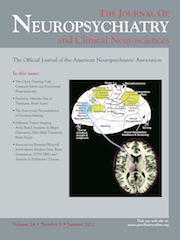Venlafaxine Augmentation With Lithium Leading to Serotonin Syndrome
To the Editor: Serotonin syndrome is a potentially life-threatening condition associated with increased serotonergic activity in the central nervous system. The serotonin syndrome is often described as a clinical triad of mental-status changes, autonomic hyperactivity, and neuromuscular abnormalities, and is actually a spectrum of clinical findings ranging from benign to lethal.
Case Report
Ms. A was a 42-year-old Caucasian female admitted to the psychiatric unit with worsening depressive symptoms and suicidal ideations. The patient was diagnosed with major depressive disorder in her early twenties and has had relapses on various antidepressants in the past. Currently she was on venlafaxine 225 mg extended release tablet for the past 7 months with good response. She denied any medical comorbidity and was not on any other medications. She denied any recent concomitant substance use and her urine toxicology was negative. Her physical examination and routine laboratory investigation on admission were unremarkable.
Considering the patient’s past history and failure to respond to various antidepressants in the past, augmentation with lithium was considered at this time. Lithium carbonate was started at dose of 300 mg/day and increase to 600 mg/day on day 4 of admission. On day 5 the patient developed confusion, fever and hyper-reflexia including clonus in her ankle. Serotonin syndrome was considered and the patient was moved to an intensive care unit for close monitoring. Lithium levels were 0.2 mEq/L and lithium toxicity was ruled out. Patient did demonstrate leucocytosis and elevated creatine phosphokinase in her laboratory investigations.
Her psychotropic medications were discontinued and supportive care was provided. Patient has some intermittent agitation which was treated with lorazepam. The patient’s condition improved over the next 4 days and was moved back to the psychiatric unit. She was reintroduced to venlafaxine again and later augmented with aripiprazole and had a good response to the same.
Discussion
Serotonin toxicity has been traditionally seen with high doses of serotonergic antidepressants or their combination. Recently various pro-serotonergic drugs have been implicated in serotonin syndrome if used along with antidepressants. Lithium and venlafaxine combination has been previously described to cause serotonin syndrome,1–3 however the mechanism is unclear. Lithium is known to increase serotonin levels in the cerebrospinal fluid by inducing serotonin synthesis4 and is supported by animal studies where is enhances the serotonin toxicity.5 Pharmacokinetic interaction where lithium reduces the renal excretion of venlafaxine has not found to be clinically significant.6 This mechanism is less likely in our case as the patient maintained adequate renal function reflected in her laboratory investigation.
Physicians should be aware and educate the patients on the risk of serotonin toxicity when various pro- serotonergic agents are used in patients previously stable on their antidepressant regimen.
1 : Lithium and venlafaxine interaction: a case of serotonin syndrome. J Clin Pharm Ther 2006; 31:397–400Crossref, Medline, Google Scholar
2 : A case of serotonin syndrome caused by venlafaxine and lithium. Pharmacopsychiatry 1997; 30:272–273Crossref, Medline, Google Scholar
3 : Prolonged serotonin toxicity with proserotonergic drugs in the intensive care unit. Crit Care Resusc 2009; 11:272–275Medline, Google Scholar
4 : Overview of the mechanism of action of lithium in the brain: fifty-year update. J Clin Psychiatry 2000; 61(Suppl 9):5–15Medline, Google Scholar
5 : A review of the biochemical and neuropharmacological actions of lithium. Psychol Med 1987; 17:579–600Crossref, Medline, Google Scholar
6 : Pharmacokinetic interaction between multiple-dose venlafaxine and single-dose lithium. J Clin Pharmacol 1996; 36:175–181Crossref, Medline, Google Scholar



